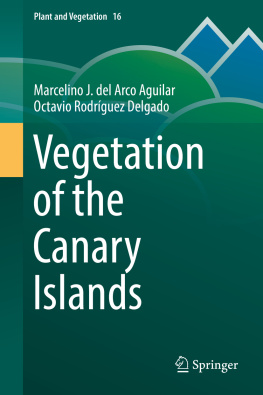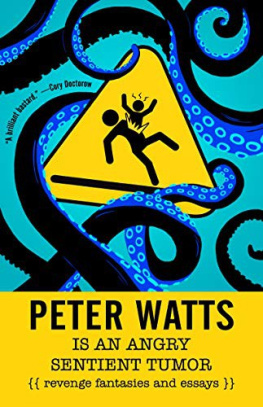VEGETATION AND BIOGEOGRAPHY
OF THE SAND SEAS OF
SAUDI ARABIA
The sand seas of Saudi Arabia, although well-known in literature, remain poorly explored scientifically. This is the first book to analyse, both quantitatively and qualitatively, the patterns, nature, and communities of the vegetation of the sand seas, using new tech-niques which the authors hope will prove adaptable for similar stud-ies in other areas. The book covers such topics as the natural envi-ronment of the sand seas, vegetative paleohistory and the impor-tance of the sand seas as a recreational area.
David Watts was Professor of Geography at the University of Hull.
Abdulatif H. Al-Nafie is Professor of Geography at the Islamic University of Imam Muhammad Ibn Saud, in Riyadh.
VEGETATION AND BIOGEOGRAPHY
OF THE SAND SEAS OF
SAUDI ARABIA
David Watts and Abdulatif H. Al-Nafie
First published 2003 by
Kegan Paul Limited
Published 2013 by Routledge
2 Park Square, Milton Park, Abingdon, Oxon 0X14 4RN
711 Third Avenue, New York, NY 10017, USA
Routledge is an imprint of the Taylor & Francis Group, an informa business
Kegan Paul, 2003
All Rights reserved. No part of this book may be reprinted or reproduced or utilised in any form or by any electric, mechanical or other means, now known or hereafter invented, including photocopying or recording, or in any information storage or retrieval system, without permission in writing from the publishers.
ISBN: 0-7103-0619-9
ISBN 978-0-710-30619-7 (hbk)
British Library Cataloguing in Publication Data
A catalogue record for this book is available from the British Library
Library of Congress Cataloging-in-Publication Data
Applied for.
The sand seas of Saudi Arabia are well known in literature, but still poorly explored in the scientific field. Consisting of vast areas of now largely stable sand, and often standing a few hundred metres above the surrounding land, sand seas cover about one third of the interior of the Arabian peninsula, and the largest (Ar Rub'Al Khali, or The Empty Quarter) extends over 640,000 km2, being 2.62 times the size of the United Kingdom, and slightly larger than France. Difficult to access by outsiders, they are even now best known to Bedouin groups, who are needed as guides to scientific explorers. Even so, it is unwise to attempt to penetrate them in the extremely hot, dry summers, and research workers are advised to wait until the cooler and wetter (especially in the north) winters, when profuse displays of annuals mix in with the many perennials to create a desert bloom of varied vegetation. To the south, Ar Rub'Al Khali is daunting merely in view of its scale, and is dry all year except for summer showers.
Although most of the wealth of Saudi Arabia's flora lies in the wetter and hilly south-west of the country, the sand seas are covered by a relatively diverse range of plant species, with several distinctive plant communities. This is the first book to consider and analyse as a whole, both quantitatively and qualitatively, the patterns, nature and communities of the vegetation of the sand seas, using new techniques which the authors hope will prove adaptable for similar studies in other arid areas. Using mainly new data, but also harking back to some of the descriptions of old, the book covers such topics as the natural environment of the sand seas, their development over time, their vegetative palaeohistory, the plants which grow on them and their biogeographic affinities, the flora of the sand seas and its adaptation to a difficult environment, an analysis of the main plant communities therein, the uses of the vegetation by man (for animal grazing, food, medicinal purposes, industry), and the importance of the sand seas as a recreational area. The result, we trust, is a sound, complete and readable analysis of the vegetation of the sand seas, and one which will be of especial use to biogeographers, ecologists, and environmental scientists, planners, conservationists, and all those interested in the preservation of Saudi Arabia's magnificent natural heritage.
In a work of this nature, the authors are clearly indebted to many people for their support, their time and their interchange of ideas. Financial support is acknowledged from the Government of Saudi Arabia, their Cultural Mission in London and the Islamic University of Imam Mohammed Ibn Saud, Ar Riyadh. In Saudi Arabia, sincere appreciation is expressed to Dr. S. Chaundhary for his knowledge of many areas, and his help in the identification of plant species; Abdullah Al-Shanqity for his advice in the selection of soil samples; and to all Riyadh, for help in analysing our soil samples. In the United Kingdom, Dr. T.A. Cope at the Royal Botanic Gardens, Kew; and Dr A.G. Miller, of the Royal Botanic Gardens, Edinburgh, both provided valuable taxonomic advice. Mr Keith Scurr of the department of Geography, University of Hull, compiled most of the drawings.
Within the sand seas, special thanks go to Abdulrahman Al-Udhayb, Abdullah Al-Nafea, Sulayman Al-Nafea, Khalid Al-Nussar, Sulayman Al-Utaywe, Saleh al-Ribdy, Ibraheem Al-Ridby, Rafat Al-Zinaty, Ahmad Al-Shaba'an, Khalid Al-Jawfy, Mutlaq Al-Subaya'y, Abdullah Al-Warthan, Fahad Al-Dawsari, Hajaj Al-Subaya'y, and Ubayan Al Subaya'y for much local information on the sand seas in their respective areas, and for their hospitality and assistance during the reconnaissance survey, and the main field-work period; also, to the brothers of the Saudi author, Abdulmohsin, Ahmed, Badir, Nasir, muhamed, Ayman and Sami, along with other family members, for their back-up support during the field seasons.
Last but not least, thanks are due to Ms Kathryn Spry, who read the original manuscript; and to Mr Mark Carmichael who word processed the final document.
To our wives, Nancy and Amsha, without whose support
and understanding this book would not have been completed
CONTENTS
Saudi Arabia extends over an area of 2,200,518 km2, or about 68.5% of the Arabian peninsula. This huge mass of land makes it the tenth largest country of the world in terms of area, covering about 1.47% of the earth's land surface, and about 5% of the Asian continent. It is nearly half the size of Europe. Saudi Arabia extends over 16 degrees of latitude, from 32 15 at the Jordanian frontier in the north to 16 30 at the border of Yemen; and between 34 E and 56 E longitude ().
Within this area, sand seas, which may be defined as extensive areas of now largely-stable sand, cover about one third of the interior, constituting one of its most prominent physical features. From north to south, they are named 1) The Great Nafud; 2) Ad Dahna; 3) a group of sand dune bodies that extend along the western side of the Tuwayq escarpment; and 4) Ar Rub' Al Khali (the Empty Quarter), including Nafud Al Jafurah. Of these Ar Rub'Al Khali is by far the largest, extending over 640,000 km2, or an area 2.62 times the size of the United Kingdom, and just a little larger than France. The Great Nafud, or An Nafud, is the second largest body of sand, covering about 62,884 km . These two sand bodies are connected by the Ad Dahna sand belts, which extend approximately 1,425 kms from southeast of An Nafud to the northern areas of Ar Rub'Al Khali. These sand seas, and others that are interspersed within the interior part of the Arabian peninsula, have within them a complex variety of dune forms, including traverse, longitudinal, star and red sand mountains, some of which reach heights of 300m above the general land surface.

















